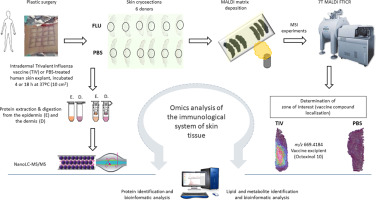当前位置:
X-MOL 学术
›
J. Proteomics
›
论文详情
Our official English website, www.x-mol.net, welcomes your feedback! (Note: you will need to create a separate account there.)
Mechanisms of innate events during skin reaction following intradermal injection of seasonal influenza vaccine.
Journal of Proteomics ( IF 3.3 ) Pub Date : 2020-01-25 , DOI: 10.1016/j.jprot.2020.103670 Jessica Gonnet 1 , Lauranne Poncelet 2 , Celine Meriaux 3 , Elena Gonçalves 1 , Lina Weiss 4 , Nicolas Tchitchek 5 , Eric Pedruzzi 1 , Angele Soria 6 , David Boccara 7 , Annika Vogt 4 , Olivia Bonduelle 1 , Gregory Hamm 8 , Rima Ait-Belkacem 8 , Jonathan Stauber 8 , Isabelle Fournier 3 , Maxence Wisztorski 3 , Behazine Combadiere 1
Journal of Proteomics ( IF 3.3 ) Pub Date : 2020-01-25 , DOI: 10.1016/j.jprot.2020.103670 Jessica Gonnet 1 , Lauranne Poncelet 2 , Celine Meriaux 3 , Elena Gonçalves 1 , Lina Weiss 4 , Nicolas Tchitchek 5 , Eric Pedruzzi 1 , Angele Soria 6 , David Boccara 7 , Annika Vogt 4 , Olivia Bonduelle 1 , Gregory Hamm 8 , Rima Ait-Belkacem 8 , Jonathan Stauber 8 , Isabelle Fournier 3 , Maxence Wisztorski 3 , Behazine Combadiere 1
Affiliation

|
The skin plays a crucial role in host defences against microbial attack and the innate cells must provide the immune system with sufficient information to organize these defences. This unique feature makes the skin a promising site for vaccine administration. Although cellular innate immune events during vaccination have been widely studied, initial events remain poorly understood. Our aim is to determine molecular biomarkers of skin innate reaction after intradermal (i.d.) immunization. Using an ex vivo human explant model from healthy donors, we investigated by NanoLC-MS/MS analysis and MALDI-MSI imaging, to detect innate molecular events (lipids, metabolites, proteins) few hours after i.d. administration of seasonal trivalent influenza vaccine (TIV). This multimodel approach allowed to identify early molecules differentially expressed in dermal and epidermal layers at 4 and 18 h after TIV immunization compared with control PBS. In the dermis, the most relevant network of proteins upregulated were related to cell-to-cell signalling and cell trafficking. The molecular signatures detected were associated with chemokines such as CXCL8, a chemoattractant of neutrophils. In the epidermis, the most relevant networks were associated with activation of antigen-presenting cells and related to CXCL10. Our study proposes a novel step-forward approach to identify biomarkers of skin innate reaction. SIGNIFICANCE: To our knowledge, there is no study analyzing innate molecular reaction to vaccines at the site of skin immunization. What is known on skin reaction is based on macroscopic (erythema, redness…), microscopic (epidermal and dermal tissues) and cellular events (inflammatory cell infiltrate). Therefore, we propose a multimodal approach to analyze molecular events at the site of vaccine injection on skin tissue. We identified early molecular networks involved biological functions such cell migration, cell-to-cell interaction and antigen presentation, validated by chemokine expression, in the epidermis and dermis, then could be used as early indicator of success in immunization.
中文翻译:

季节性流感疫苗皮内注射后皮肤反应过程中的先天事件机制。
皮肤在抵抗微生物侵袭的宿主防御中起着至关重要的作用,先天细胞必须为免疫系统提供足够的信息来组织这些防御。这种独特的功能使皮肤成为疫苗接种的有希望的场所。尽管已经对疫苗接种过程中的细胞先天免疫事件进行了广泛研究,但对初始事件的了解仍然很少。我们的目标是确定皮内(id)免疫后皮肤先天反应的分子生物标志物。我们使用来自健康捐献者的离体人类外植体模型,通过NanoLC-MS / MS分析和MALDI-MSI成像进行了研究,以检测季节性三价流感疫苗(TIV)注射后几小时的先天分子事件(脂质,代谢产物,蛋白质) )。与对照PBS相比,这种多模型方法可以识别TIV免疫后4和18 h在真皮层和表皮层中差异表达的早期分子。在真皮中,最相关的蛋白质上调网络与细胞间信号传导和细胞运输有关。检测到的分子标记与趋化因子如CXCL8(嗜中性粒细胞的化学吸引剂)有关。在表皮中,最相关的网络与抗原呈递细胞的激活有关,并且与CXCL10有关。我们的研究提出了一种新颖的逐步方法来鉴定皮肤先天反应的生物标志物。意义:据我们所知,尚无研究分析皮肤免疫部位对疫苗的先天分子反应。已知皮肤反应基于宏观(红斑,发红...),微观(表皮和真皮组织)和细胞事件(炎性细胞浸润)。因此,我们提出了一种多模式方法来分析皮肤组织上疫苗注射部位的分子事件。我们确定了涉及生物学功能的早期分子网络,如细胞迁移,细胞间相互作用和抗原呈递,通过趋化因子在表皮和真皮中的表达进行了验证,然后可以用作免疫成功的早期指标。
更新日期:2020-01-26
中文翻译:

季节性流感疫苗皮内注射后皮肤反应过程中的先天事件机制。
皮肤在抵抗微生物侵袭的宿主防御中起着至关重要的作用,先天细胞必须为免疫系统提供足够的信息来组织这些防御。这种独特的功能使皮肤成为疫苗接种的有希望的场所。尽管已经对疫苗接种过程中的细胞先天免疫事件进行了广泛研究,但对初始事件的了解仍然很少。我们的目标是确定皮内(id)免疫后皮肤先天反应的分子生物标志物。我们使用来自健康捐献者的离体人类外植体模型,通过NanoLC-MS / MS分析和MALDI-MSI成像进行了研究,以检测季节性三价流感疫苗(TIV)注射后几小时的先天分子事件(脂质,代谢产物,蛋白质) )。与对照PBS相比,这种多模型方法可以识别TIV免疫后4和18 h在真皮层和表皮层中差异表达的早期分子。在真皮中,最相关的蛋白质上调网络与细胞间信号传导和细胞运输有关。检测到的分子标记与趋化因子如CXCL8(嗜中性粒细胞的化学吸引剂)有关。在表皮中,最相关的网络与抗原呈递细胞的激活有关,并且与CXCL10有关。我们的研究提出了一种新颖的逐步方法来鉴定皮肤先天反应的生物标志物。意义:据我们所知,尚无研究分析皮肤免疫部位对疫苗的先天分子反应。已知皮肤反应基于宏观(红斑,发红...),微观(表皮和真皮组织)和细胞事件(炎性细胞浸润)。因此,我们提出了一种多模式方法来分析皮肤组织上疫苗注射部位的分子事件。我们确定了涉及生物学功能的早期分子网络,如细胞迁移,细胞间相互作用和抗原呈递,通过趋化因子在表皮和真皮中的表达进行了验证,然后可以用作免疫成功的早期指标。



























 京公网安备 11010802027423号
京公网安备 11010802027423号